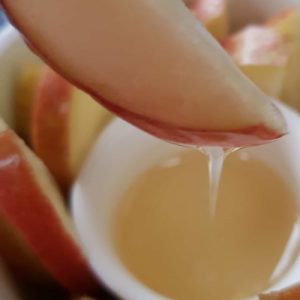
In our family, we celebrate Shabbat each week and Passover each year so I wanted to look at the Jewish ‘High Holy Days’ as they are known, to find some rituals we could use to enrich our faith at home. I’m not going to give an exhaustive overview here, (because you have google too!) but focus on what elements we could adapt and use.
In Autumn there are three main Jewish festivals:
1 Rosh Hashana (Jewish New Year) 18/19 September 2020
2 Yom Kippur (the Day of Atonement) 27/28 September 2020
3 Sukkot (Festival of Shelters) 2 – 9 October 2020
Rosh Hashana is followed by the Days of Awe, ten days of soul searching and repentant prayer. These lead up to Yom Kippur, the day of forgiveness. Sukkot follows on five days later.
Here are some options of ways you could incorporate these festivals into your faith at home:
1 Rosh Hashana
Blow a loud wind instrument
Rosh Hashana is a day when God’s people celebrate God making the world, and that He is King of the Universe. There’s something about declaring this which puts our troubles into perspective. At Rosh Hashana, also known as the Festival of Trumpets, the shofar or ram’s horn trumpet is blown as a celebration of God being King of the universe (the shofar is traditionally used at a king’s coronation). If you don’t have a shofar handy (!) you could use a trumpet, a recorder or even a cardboard tube, and say this blessing:
“Baruch atah Adonai eloheinu melech ha-olam.”*
“We bless you, Lord our God, King of the Universe!”
*If you’d like to hear how this is sung, listen to this
Bake some honey mini muffins
We love food related rituals, and Jewish festivals are good for foodies! At Rosh Hashana it’s traditional to eat sweet foods, especially honey, to represent a sweet new year. In the past we have enjoyed dipping apple slices in honey but this year we will try these honey cake mini muffins from EverydayJewishMom:
1 Preheat your oven to 210oC
2 Grease your mini-muffin tin.
3 Mix 2 cups plain flour with 1 tsp baking powder, 0.5 tsp baking soda and a pinch of cinnamon.
4 In another bowl mix 2 eggs, 0.75 cup of honey, 0.5 cup coffee, and 1 tbs coconut oil.
5 Mix the ingredients of the two bowls together.
6 Add 2 small diced apples.
7 Fill the mini-muffin tins to the top.
8 Bake for 12-15 mins.
If you’re more of a bread person, why not try making a round, honey-dipped challah bread instead? The shape represents God’s King of the Universe crown and eternal life. You’ll find good recipes at www.toriavey.com We also found this fab song to go with dipping apples in honey.
Throw some bread crumbs into water
One Rosh Hashana, Jews perform taschlich which involves visiting a ‘body of water’ (for us this would be our local river) and throwing breadcrumbs into it as a symbol of casting away our sins, which recalls Micah 7:19 “You will trample on our sins / and throw them in the sea.”
I know lots of families do TSP prayers, encouraging their children to say Thank you, Sorry and Please each day. We do a weekly ‘sorry’ when we wash our hands at our Shabbat meal on a Friday, but I like the idea of using a different physical ritual to let us imagine and experience God’s forgiveness in a different way. If you don’t have any water near you, you could ad lib with a bowl or the bath!
Read the whole story of Isaac
During Rosh Hashana, the whole of the story of Isaac will be read from Genesis 21-22 in the synagogue. I love the idea of reading large chunks of the Bible, so our challenge is to find a good time to read this whole story from the Bible (we’ll read chapters 23 and 24 as well, and might also do the Godly Play version which will give us a shorter overview but also a way to play with the story and explore where we are in it).
2 Yom Kippur
Fasting
On Yom Kippur it’s traditional to fast so as to ignore our physical desires, and instead focus on our spiritual needs. This is always hard, but a good way to focus on what really matters, as Jesus quoted from Deuteronomy 8:3: “man does not live on bread alone but on every word that comes from the mouth of the LORD.”
Wear white clothes
This is done by some Jews on Yom Kippur as a symbol of purity because it’s a day of spiritual cleansing. It may also relate to the special garments the High Priest wore when doing the rituals in the Holy of Holies as written in Leviticus 16. Why not try wearing one white item for the day as a way of remembering what Jesus, our Great High Priest did for us (Hebrews 4:14-16).
3 Sukkot
Eating in a shelter
The main ritual for Sukkot is to erect a sukkah, a small, temporary booth or shelter, and ‘live’ in it for seven days (this year Oct 4-11, five days after Yom Kippur). Sukkot commemorates the 40 years God’s people wandered in the desert and the shelters represent the frail huts the Israelites lived in in the desert, and how God provided for them then, and by inference, provides for His people today. Living in the shelter is interpreted in many ways. Why not try sitting, eating (a meal or a snack), star gazing, playing a game and even sleeping in it.
We have made a shelter in various ways, including putting up a tent in the garden. Traditionally the booth is covered with fruit, as Sukkot is a celebration of the Autumn harvest. You could make a ‘den’ using bamboo sticks and cover it will a sheet, and eat a meal or a snack there. Chat about what it would have been like to live in the desert. What do you think you would have enjoyed? What might you have disliked?
Wave branches and a lemon!
The details of the festival of shelters can be found in Leviticus 23:33-44, including the verse which says to “take branches from luxuriant trees—from palms, willows and other leafy trees—and rejoice before the LORD your God for seven days”.
One Jewish tradition is to do this by making a lulav, which is a combination of date palm, willow and myrtle branches, held together by a woven palm branch. The etrog, is a fruit a bit like a lemon with a citrus smell. A prayer is said over the lulav and etrog then they are waved in six directions—north, south, east, west, up, and down – to symbolize that God can be found in all directions, not just in one place.
Read some Psalms
Traditionally the Psalms to read during Sukkot are Psalm 113 – 118. Why not try reading one each day for a week?

Explore and celebrate more Autumn feasts in your home with the GodVenture Autumn Feasts Resource Pack
